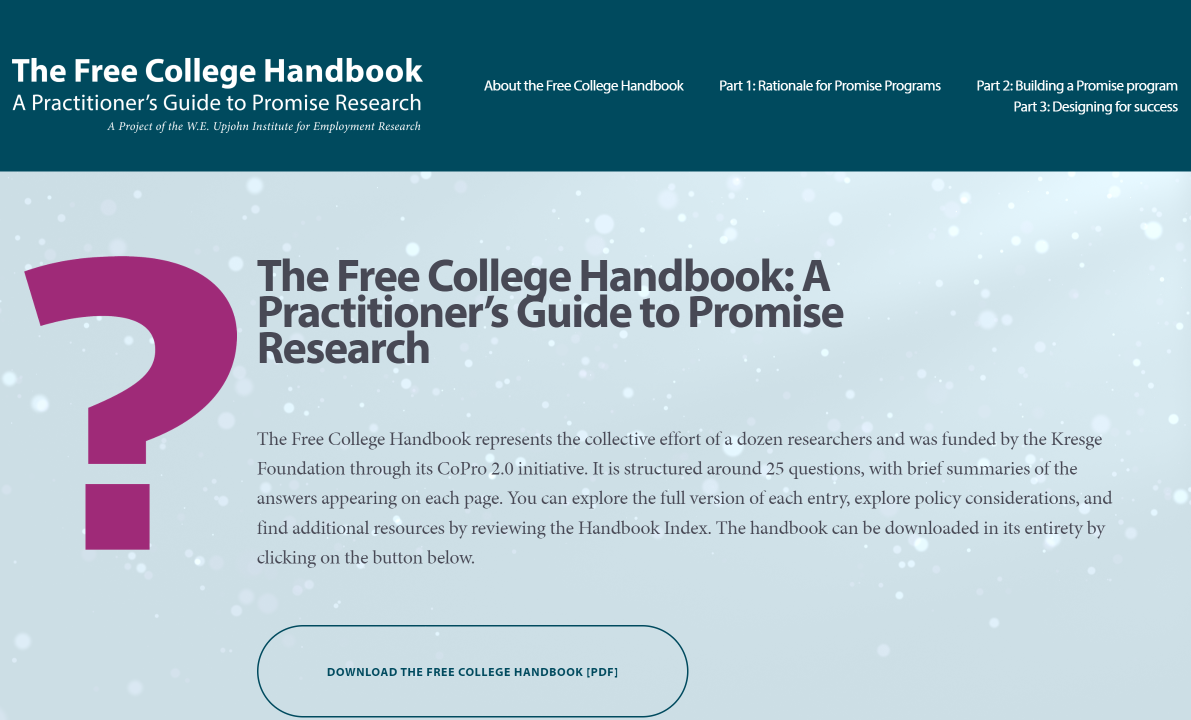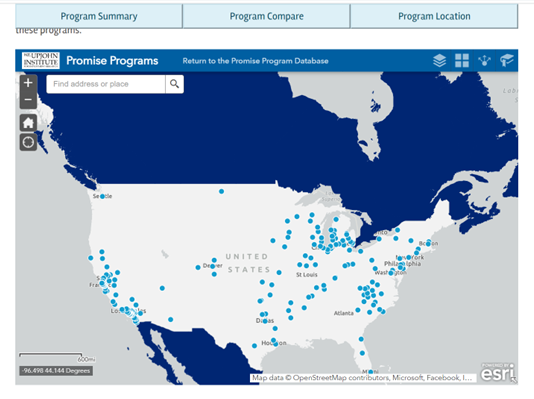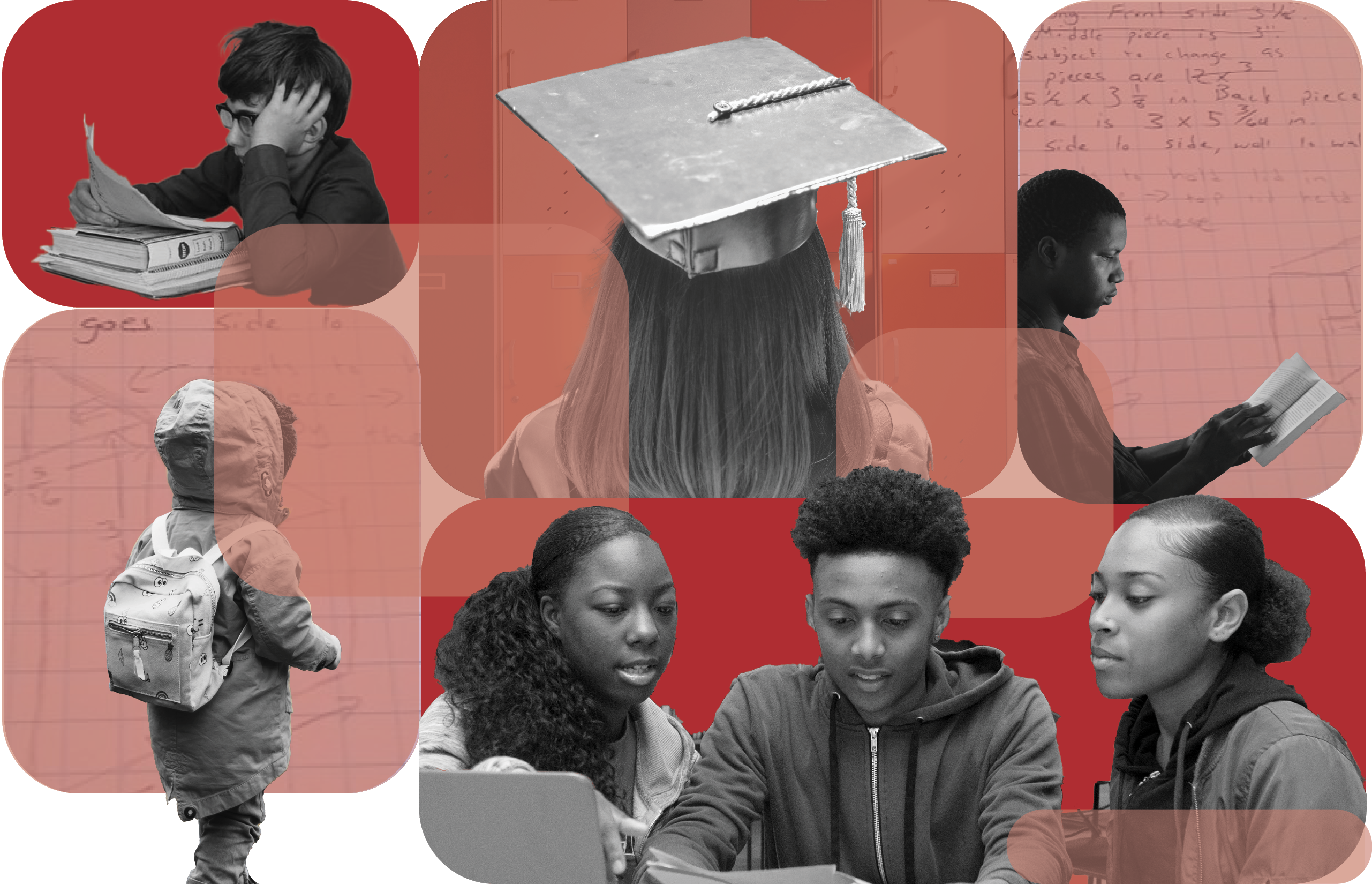Free college programs expand access to higher education. To sustain these Promise programs for the future, public-private partnerships, tax-capture mechanisms, and long-term public funding are key.

Illustration by Kathleen Bolter; Photographs by Karolina Grabowska via Pexels; Roman Kraft and Donald Teel via Unsplash; and Schindlerdigital via Wikimedia.
In September 2023, Pittsburgh Public Schools (PPS) students received a letter confirming that the Pittsburgh Promise—a place-based scholarship launched in 2008—would conclude in 2028. Even though the program’s end had been signaled for years, the announcement was still met with shock and a fair amount of confusion. Why would PPS stop granting scholarships? It didn’t: The Pittsburgh Promise is a private initiative not operated by the school district. Had it “worked”? It depends; the metrics by which the success of any Promise program can be judged are complex and multifaceted.
Most pressing, why would Pittsburgh’s large business and foundation sector suddenly end its support for such a worthwhile endeavor? As it turns out, fundraising had been challenging for years, and the program is expensive to run.
The formal announcement of the end of the Pittsburgh Promise sent a shudder of unease through the College Promise community. Here was one of the nation’s most mature Promise programs, in one of its biggest cities, calling it quits. What does this foretell for the more than 250 states, cities, and community colleges that have embraced place-based, tuition-free college?
Philanthropy’s Role in Promise Programs
Like most other tuition-free college programs, the Pittsburgh Promise is funded by foundation, corporate, and individual contributions. It began with a $100 million “challenge grant” from UPMC, the University of Pittsburgh Medical Center, the area’s largest employer, that asked the Pittsburgh Promise to raise $15 million a year over 10 years to unlock a $10 million annual UPMC contribution. Fund development was thus a priority from the beginning, and funds were spent as they were being raised. The amount and structure of the scholarship were revised periodically to accommodate financial projections, but as time went by, costs rose faster than its funders’ ability and willingness to give. Beginning in 2015, program leaders began discussing its “sunset,” possibly as early as 2022.
Pittsburgh Promise executive director Saleem Ghubril, who has served in the role since the program’s launch, says the program “never was a perpetual fund. It was always a fundraising campaign that will raise and spend and raise and spend.”
Still, the Pittsburgh Promise had longevity and scale: by the time it ends, 21 classes of high school graduates will have been served, with more than $250 million raised toward scholarships for 11,600 students. Its apparent conclusion nonetheless has upended many people’s expectations.
The Role of Philanthropies
The role of philanthropy in Promise programs is as unique as the communities served.
The Kalamazoo Promise
For the Kalamazoo Promise, fund development came even before the program was announced, with a group of deep-pocketed anonymous donors creating the initiative and committing to funding it in perpetuity. There is no endowment; rather, the donors provide resources to the organization annually. As the Kalamazoo Promise has evolved, the nature of the philanthropic commitment has also changed, from paying for scholarships to investing in new approaches to connect Promise scholars to employment and deepen support for students at local institutions.
The El Dorado Promise
In Arkansas, the El Dorado Promise, one of the first programs to emulate the Kalamazoo Promise, was funded with a $50 million gift from Murphy Oil Corporation, the community’s largest employer. Although the company’s headquarters has moved out of state, it continues to support the program.
The Bearcat Advantage
Foundation funding is at the heart of many Promise programs. Local and community foundations have been deeply involved as partners in tuition-free college in many places. One of the most recent examples is the Bearcat Advantage, a generous scholarship for Battle Creek Public Schools’ students funded by the W.K. Kellogg Foundation through its hometown programming.
New philanthropic efforts mean the number of communities guaranteeing tuition for their graduates continues to increase. In one recent example, a pair of wealthy Chicago residents brought together education leaders and philanthropists to launch the ambitious Hope Chicago program in 2022 at five public high schools. They are seeking to raise $1 billion over the next decade to cover the full cost of college for participating students.
New Models for Promise Program Funding
While the Pittsburgh Promise was struggling to make its financial models work, a different approach was yielding a growing pool of resources. The Michigan Promise Zones, created by Governor Jennifer Granholm in 2009 and expanded by Governor Rick Snyder in 2017, use an innovative funding approach that blends local philanthropic resources with a tax-capture mechanism generally used for economic development purposes. Tax-increment financing (TIF) arrangements are based on property taxes: as property values rise, so do the tax revenues available for school funding, with a fraction of that increase dedicated to the Zones. Under this system, there is built-in potential for expansion without the need to continually fundraise.
Even as public funding models, especially for statewide Promise programs, expand, there will always be a role for philanthropy. Untested innovations are unlikely to attract public funding—and it has been difficult to leverage public funds for the support services that are essential to student success. Michigan Reconnect, a state-funded initiative providing tuition-free community college to any adult without a college degree, enjoys bipartisan support; however, public funding provides for only a tiny number of “navigators,” whose job it is to help students select an appropriate postsecondary pathway. The Tennessee Promise is nearing its second decade of operation and, while it is publicly funded, ongoing innovation around student support depends on businesses and foundations. A key part of the early impact of the Columbus Promise has come from the involvement of an existing philanthropically funded nonprofit organization, I Know I Can, that helps students learn about and apply for the scholarship.
Building Philanthropic and Public-Sector Partnerships
Philanthropy has well-known limitations and drawbacks, and these apply to Promise programs as much as to any philanthropically funded initiative. The priorities of foundations and donors change over time, “solutions” can be mere Band-Aids masking deeper problems, measuring impact can be difficult, and unintended consequences abound. When it comes to the expense involved in higher education, even the largest foundations can’t compete with the potential size and longevity of government programs.
There is a deeper reason for public support. Investments in higher education, including Promise programs that increase earnings and the vitality of low-income communities, have benefits that far exceed their costs. However, even with high social and economic returns, these programs are unlikely to pay for themselves, and certainly not in the short term. In addition, the provision of higher education is expensive, with costs certain to rise over time. Making a permanent commitment to a sizable investment that will generate benefits over the long term is beyond the scope of philanthropy and an appropriate arena for government funding.
That’s why philanthropists should look for ways to share key lessons not just with other private donors, but also with state and local governments. Philanthropy can help build the Promise evidence base through investments in research and evaluation, which are relatively rare. If a philanthropic effort comes with a rigorous evaluation that demonstrates effectiveness, public-sector leaders will have greater confidence in scaling programs up.
Philanthropy can catalyze the work, seed new ideas, and help disseminate best practices. But if the benefits of tuition-free college—more equitable access to higher education, a better-prepared workforce, and stronger state, regional, and local economies—are to reach more places and people, the public sector must take up the baton from the philanthropies that helped pioneer this movement.
As Saleem Ghubril noted in the days following the September announcement, “The private sector cannot do this alone.” Pittsburgh Public Schools officials concur; they say they will continue working with the Pittsburgh Promise until and beyond the 2028 end date, but they’re looking to the public sector to “commit to a sustainable policy solution for funding postsecondary education in Pennsylvania.”
Policy Recommendations
• Diversify funding sources, including exploring public-private partnerships, tax-capture mechanisms, and long-term public funding to create a more sustainable financial model for Promise programs.
• Encourage philanthropic organizations to continue to play a role in Promise programs by piloting innovations and disseminating best practices.
• Invest in research and evaluation of Promise programs to understand their impact, share successful practices, and guide effective policies for both public and private sectors.
Interview with the author
Author




